

|
Back to |
| The Front Page |
| Letters & Opinion |
|
Whites by Gail Arkley layout by Reuben Edwards posted December 9, 2013
|
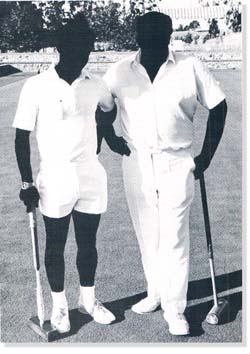
|
| This illustration appeared in the original publication of this essay, in the fall of 1986. The two men in blazing whites are the first two pros in Northern California, snapped by Carl Livingston at Sonoma-Cutrer. Can you identify the other well-known croquet figures in the uncaptioned photos below? |
Similarly, upon exposure to croquet, the ironwood mallet differentiated from the linen, the Jacques balls from the Australian, the cast iron from the winter wickets. Later, all croquet courts stopped looking like indoor-outdoor carpets and differentiated into ryegrass or bentgrass, on sand or decomposed granite, with assorted weed infestations and varying degrees of flatness.
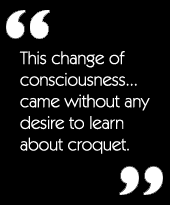 This change of consciousness was gradual. Unlike that accompanying mushroom hunting, it came without recourse to reference books filled with color photographs. It also came without any desire on my part to learn about croquet.
This change of consciousness was gradual. Unlike that accompanying mushroom hunting, it came without recourse to reference books filled with color photographs. It also came without any desire on my part to learn about croquet.
That's what bothers me. Now, croquet trivia crowds my consciousness. Once, a "bisque" was a soup; now it is a handicap. Formerly, a "rover" peregrinated, a "wicket" was a type of gate, "penultimate" was a word found in literary criticism, and "the English game" was cricket. Now I know better.
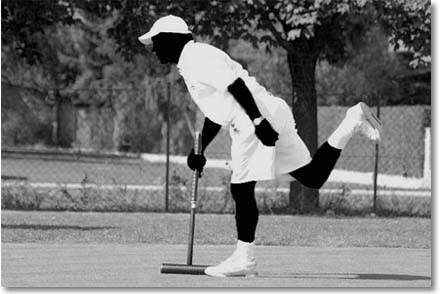
|
Still, I have learned to tolerate these niggling inroads into my interior monologue. More difficult to recognize and accept has been the evolution of my aesthetic sense. The first intrusion into my aesthetic came by way of croquet trivia. Croquet has colors. Not the wide assortment of colors on the wooden balls we remember using as kids during the long summer evenings spent playing the backyard variety, but four colors which actually mean something in the game. Red and yellow, black and blue. The primary colors--and black.
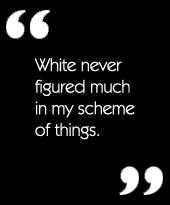 Now, whenever I see only one, two, or three of these colors, I think something is missing. And, it is surprising how often the four colors are combined on a white background, but with one problem: the inclusion of green. Such schemes look somehow contaminated with that fifth, non-croquet addition.
Now, whenever I see only one, two, or three of these colors, I think something is missing. And, it is surprising how often the four colors are combined on a white background, but with one problem: the inclusion of green. Such schemes look somehow contaminated with that fifth, non-croquet addition.
However, it wasn't so much the colored balls as it was the omnipresent white which influenced me.
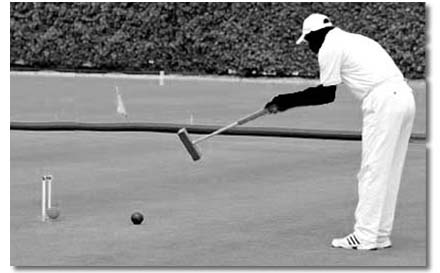
|
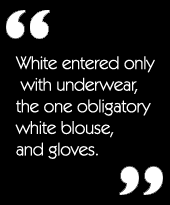 White never figured much in my scheme of things. As a child I always had a favorite color. It varied, but it was never white. White entered only with underwear, the one obligatory white blouse, and gloves. Everything else one wore was colored, even socks. Well, maybe a pair of white sandals for summer. Plumbing fixtures were white; so were sheets. White carried a clinical aura of doctor and dentist. A nurse, clothed in white from cap to uniform to stocking and sensible rubber soled shoes seemed strangely discordant outside the medical setting; at the bus stop, for example.
White never figured much in my scheme of things. As a child I always had a favorite color. It varied, but it was never white. White entered only with underwear, the one obligatory white blouse, and gloves. Everything else one wore was colored, even socks. Well, maybe a pair of white sandals for summer. Plumbing fixtures were white; so were sheets. White carried a clinical aura of doctor and dentist. A nurse, clothed in white from cap to uniform to stocking and sensible rubber soled shoes seemed strangely discordant outside the medical setting; at the bus stop, for example.
In college, white walls were the fashion, all the better for displaying posters and reproductions of the French Impressionists. That period passed through, and white receded, reappearing in the occasional snowfall, or motel linens.
 Actually, for me it was best avoided. I may be tidy, but I'm not neat. Colored food inevitably lands outside the napkin's boundary. The more colorful the food (tomato sauce, raspberry sherbet, chocolate mousse), the more likely the spot. White blouses were possible only if there were a jacket to cover and deflect stains. White slacks were an impossibility. This was fine, white's for nurses, right?
Actually, for me it was best avoided. I may be tidy, but I'm not neat. Colored food inevitably lands outside the napkin's boundary. The more colorful the food (tomato sauce, raspberry sherbet, chocolate mousse), the more likely the spot. White blouses were possible only if there were a jacket to cover and deflect stains. White slacks were an impossibility. This was fine, white's for nurses, right?
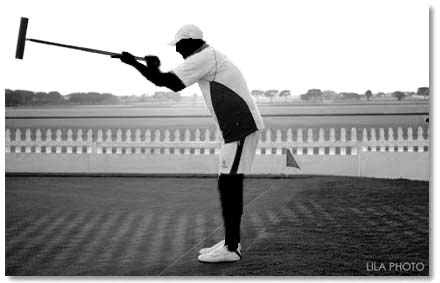
|
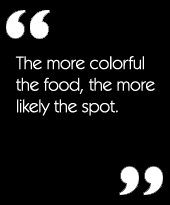 No, not any more. The first croquet tournament in which my husband participated (USCA Western Regionals, Seattle,1983) required not only that equipment be mastered, but also clothing. White clothing. Neither of us had any. I suppose I could have ignored the whole thing, but that somehow didn't seem sporting. What was the harm, I needed a few new things anyway.
No, not any more. The first croquet tournament in which my husband participated (USCA Western Regionals, Seattle,1983) required not only that equipment be mastered, but also clothing. White clothing. Neither of us had any. I suppose I could have ignored the whole thing, but that somehow didn't seem sporting. What was the harm, I needed a few new things anyway.
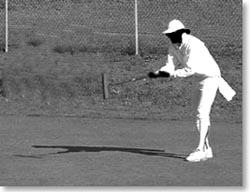
|
 What was this? Had white been around all the time, since the white sheets of childhood, without me noticing it? There was a white one of everything, it seemed. Shortly, any method there may have been early on in this tour disintegrated. Snow blindness set in. Tolerance dropped.
What was this? Had white been around all the time, since the white sheets of childhood, without me noticing it? There was a white one of everything, it seemed. Shortly, any method there may have been early on in this tour disintegrated. Snow blindness set in. Tolerance dropped.
Whites, yes, but I had to have some relief with a few colors too. The first set of "whites" was not all white--but, I figured, light enough. I had felt too much like a hospital orderly there in the dressing room. Besides, I wasn't going to be actually playing the darned game.
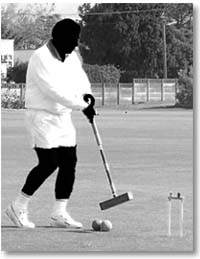
|
During that first tournament, even with my bits and pieces of color, I felt like a reflector in the bright sunlight. There was plenty of company; the courts dazzled with white players and spectators. As the summer progressed, I became more and more comfortable with my new way of dressing.
Outfits could only be worn once, maybe twice. Eating had to be relearned, spot removers and laundry products researched. Whites differentiated into many shades and nuances, some of which clashed when worn together. I bought white shoe polish for the first time since I stopped going to Sunday School. (It smells the same.)
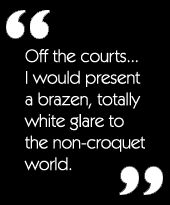 I got whiter and whiter. Colors dropped away. They were just too obtrusive. A red belt, a blue sweater; did I dare? One drawer, stacked with my neatly folded new acquisitions, could have been a linen drawer filled with piles of white sheets. On the courts, those poor folks who actually wore colors, especially dark colors, seemed to out of place! And off the courts, when I felt particularly good, I would present a brazen, totally white glare to the non-croquet world (my job, the city streets) hoping it appeared a little outrageous to others, as it once did to me.
I got whiter and whiter. Colors dropped away. They were just too obtrusive. A red belt, a blue sweater; did I dare? One drawer, stacked with my neatly folded new acquisitions, could have been a linen drawer filled with piles of white sheets. On the courts, those poor folks who actually wore colors, especially dark colors, seemed to out of place! And off the courts, when I felt particularly good, I would present a brazen, totally white glare to the non-croquet world (my job, the city streets) hoping it appeared a little outrageous to others, as it once did to me.
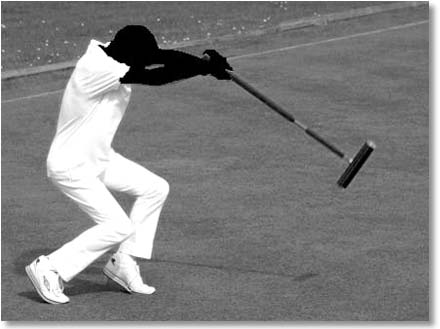
|
The realization that my perception of the nature of beauty had changed came upon me all at once while browsing in a dress shop. A shopper commented to her friend, "I don't like this one. It has too much white in it." Eagerly, I waited for them to move on, then sidled quickly to the rack they had left, hoping that whatever it was they had been discussing came in my size!
In the mid 1980s, Gail Arkley entered a new world; the world of croquet. This enterprise did require new clothes. Her husband Tremaine was a player. Tremaine was later awarded a Lifetime Membership in the Croquet Association for his achievements, the only American so honored. Tremaine and Gail have also been awarded lifetime memberships in the Scottish Croquet Association. Gail has also been married to an art collector, habitat restoration manager and a quince farmer. Their marriage has lasted over 50 years. As to colors, Gail is currently in a different phase. Her black is the new black, highlighted by a bit of gray.
We doctored slightly for this article the photos of Johnny Mitchell, Max Murray, Lila Photo, and Bob Alman.
This article originally appeared in the premiere issue of CROQUET MAGAZINE in 1986, published by Hans Peterson and edited by Mike Orgill and Bob Alman, with Gail and Tremaine Arkley (the husband in question) on the masthead as Consulting Editors. Gail contributed an essay to each issue. Croquet World will publish an extensive article in 2014 on the unique and sizeable Arkley Croquet Collection at the University of British Columbia, now being put online.